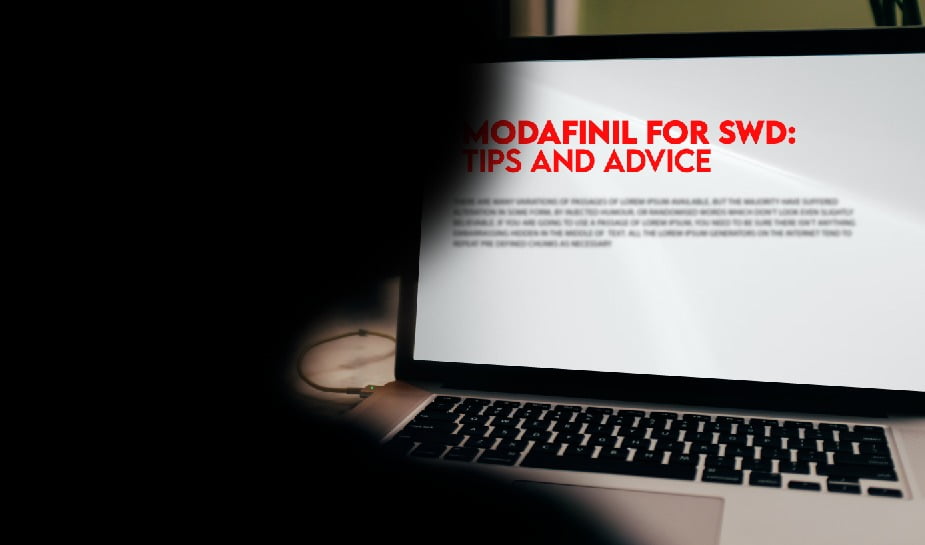Introduction
Working night shifts or irregular hours can take a toll on your body’s natural sleep-wake cycle and lead to a condition called shift work sleep disorder (SWD). SWD can cause symptoms such as excessive sleepiness, difficulty staying awake during work hours, and difficulty sleeping during the day. Modafinil is a medication that has been found to be effective in managing the symptoms of SWD.
In this blog post, we’ll discuss the use of Modafinil for Shift Work Sleep Disorder (SWD) and provide tips and advice for taking it safely and effectively.
What is Shift Work Sleep Disorder?
Shift work sleep disorder (SWD) is a condition that affects people who work non-traditional hours, such as night shifts or rotating shifts. It is characterized by symptoms such as insomnia, excessive sleepiness, and difficulty staying awake during work hours. According to the National Sleep Foundation, SWD affects approximately 10% of shift workers.

How is Shift Work Sleep Disorder Diagnosed?
Diagnosing shift work disorder typically involves a physical examination and a review of your sleep patterns and work schedule. Your doctor may also order a sleep study to evaluate your sleep quality and patterns.
What is Modafinil and How Does it Work?
Modafinil is a medication that is commonly used to treat excessive sleepiness caused by SWD, narcolepsy, and obstructive sleep apnea.

It is a wakefulness-promoting agent that works by stimulating the brain to increase wakefulness and alertness.

Is Modafinil Safe to Use for Shift Work Sleep Disorder?
When taken as directed, Modafinil is generally considered safe for use in managing the symptoms of SWD. However, like any medication, it can cause side effects. Common side effects of Modafinil include headache, nausea, and dry mouth. More serious side effects, such as skin rash and difficulty breathing, are rare but can occur. It’s important to talk to your doctor about any potential risks or concerns before taking Modafinil.
What are the Potential Side Effects of Modafinil?
In addition to the common side effects mentioned above, Modafinil can also cause more serious side effects such as chest pain, rapid heartbeat, and fever. In rare cases, it can also cause psychiatric symptoms such as hallucinations or suicidal thoughts. If you experience any of these symptoms while taking Modafinil, contact your doctor immediately.
How Should I Take Modafinil for Shift Work Sleep Disorder?
Modafinil should be taken as directed by your doctor. Typically, it is taken in the morning or an hour before the start of your shift. It should not be taken more than once per day. It’s important to avoid taking Modafinil too late in the day, as it can interfere with your ability to fall asleep at night.
Tips for Using Modafinil for Shift Work Sleep Disorder (SWDs)
If you have been diagnosed with SWD and your doctor has prescribed Modafinil as a treatment, here are some tips to help you use the medication effectively:
Follow your doctor’s instructions:
Your doctor will provide you with detailed instructions on how to take Modafinil. Be sure to follow these instructions carefully to ensure that you are taking the medication safely and effectively.
Take Modafinil at the right time:
Modafinil is typically taken one hour before the start of a shift. This helps to ensure that the medication is in your system when you need it most.
Avoid caffeine and other stimulants:
While Modafinil is a stimulant medication, it is important to avoid other stimulants such as caffeine while taking the medication. This can cause overstimulation and interfere with the medication’s effectiveness.
Stay hydrated:
Modafinil can cause dry mouth, so it’s important to drink plenty of water while taking the medication.
Monitor side effects:
Modafinil can cause side effects such as headache, nausea, and anxiety. If you experience any side effects, be sure to let your doctor know.
Are There Any Alternative Treatments for Shift Work Sleep Disorder?
In addition to Modafinil, there are other treatments that can be used to manage the symptoms of shift work disorder. These include light therapy, melatonin supplements, and lifestyle changes such as maintaining a consistent sleep schedule and creating a sleep-conducive environment.
Can Lifestyle Changes Help Manage Shift Work Disorder?
Making certain lifestyle changes can help improve the symptoms of shift work disorder. Some tips for managing SWD include:
- Maintaining a consistent sleep schedule, even on days off
- Creating a sleep-conducive environment by blocking out noise and light
- Staying hydrated and avoiding caffeine and alcohol before bedtime
- Taking short naps during breaks, if possible
FAQs:
Q: Can Modafinil be used for other sleep disorders?
A: Yes, Modafinil is also used to treat other sleep disorders such as narcolepsy and sleep apnea.
Q: Can Modafinil be habit-forming?
A: While Modafinil is not considered to be addictive, it can be habit-forming in some individuals.
Q: Is Modafinil safe for long-term use?
A: Modafinil is generally considered safe for long-term use when taken as directed by a healthcare professional.
In conclusion, Modafinil is an effective treatment for shift work disorder, and can help to improve wakefulness and reduce excessive sleepiness in shift workers. If you have been diagnosed with SWD, be sure to follow your doctor’s instructions when using Modafinil, and monitor any side effects that you may experience.
In conclusion, Modafinil can be a helpful solution for people suffering from Shift Work Disorder. It can help improve alertness, concentration, and reduce fatigue during work hours. However, it is important to use Modafinil responsibly and under the guidance of a healthcare professional. It is also important to take necessary precautions to ensure safety while operating heavy machinery or driving.
To recap the key takeaways, here are some important points to remember:
- Shift Work Disorder is a serious condition that affects many people who work non-traditional hours.
- Modafinil is a prescription medication that can help improve wakefulness, alertness, and concentration in people with Shift Work Disorder.
- Modafinil should only be used under the guidance of a healthcare professional and according to the recommended dosage instructions.
- Modafinil is generally safe, but it can cause side effects such as headaches, nausea, and anxiety.
- It is important to take necessary precautions while using Modafinil, especially when operating heavy machinery or driving.
If you are experiencing symptoms of Shift Work Disorder, consult with your healthcare provider to discuss your treatment options. Modafinil may be a good solution for you, but it is important to use it responsibly and with caution.
We hope that this article has provided you with useful information and insights into using Modafinil for Shift Work Disorder. If you have any questions or comments, please feel free to leave them below.
References:
- Centers for Disease Control and Prevention. (2017). Shift Work and Sleep. Retrieved from https://www.cdc.gov/niosh/emres/longhourstraining/modules/shiftwork.html
- National Sleep Foundation. (n.d.). Shift Work Disorder. Retrieved from https://www.sleepfoundation.org/articles/shift-work-disorder
- U.S. National Library of Medicine. (2022). Modafinil. Retrieved from https://medlineplus.gov/druginfo/meds/a602016.html
- Garbarino, S., et al. (2004). Use of modafinil for the treatment of attention deficit/hyperactivity disorder in adults. Sleep Medicine Reviews, 8(1), 93-107. doi: 10.1016/S1087-0792(03)00024-7
- Hussain, N., & Hayat, M. (2019). Modafinil in shift work disorder: A systematic review and meta-analysis. Journal of Sleep Disorders & Therapy, 8(2), 313. doi: 10.4172/
- 167-0277.1000313
WE DO NOT PROVIDE ANY MEDICAL ADVICE, AS SET FORTH IN THE WEBSITE INFORMATION DISCLAIMER.
The information on the website, including but not limited to text, graphics, photos, and other content, is only meant to be used as informational material. Nothing on this website should be construed as professional medical advice or as any kind of therapy. It is always advisable to obtain professional medical advice from a licenced expert. If you want to try a new medical procedure, you should always see a doctor beforehand. When experiencing any negative effects or pain, get medical attention right once.

